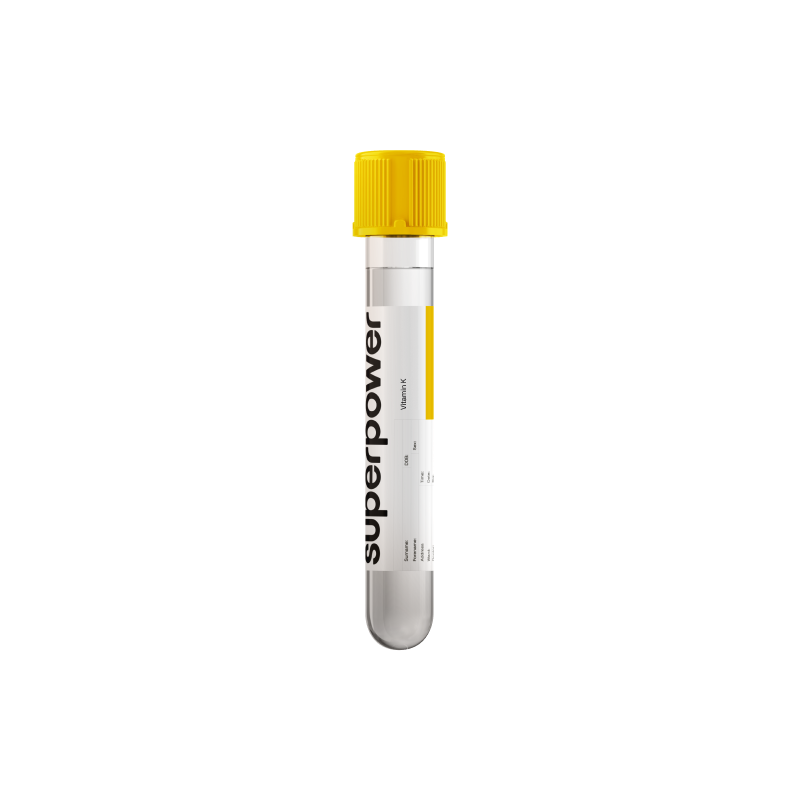Key Benefits
- Confirm vitamin K status to support normal blood clotting and strong bones.
- Spot deficiency risk when bruising, bleeding, or high INR suggests low vitamin K.
- Flag gut or liver problems that reduce vitamin K absorption or activation.
- Clarify prolonged PT/INR by distinguishing vitamin K deficiency from liver dysfunction.
- Guide targeted supplementation and leafy-green intake to correct deficiency safely.
- Protect bone strength by identifying low vitamin K linked to underactive bone-building proteins.
- Track recovery from deficiency after diet changes, supplementation, or treating gut absorption issues.
- Best interpreted with PT/INR, liver tests, medicines, and your bleeding symptoms.
What is Vitamin K?
Vitamin K is a family of fat‑soluble vitamins that the body uses to activate certain proteins. We get it mainly from plants as vitamin K1 (phylloquinone) in leafy greens and plant oils, and from bacteria as vitamin K2 (menaquinones) found in fermented foods and some animal foods; our gut microbes also make small amounts. After absorption with dietary fats, vitamin K travels to the liver and other tissues, where its different forms (e.g., MK‑4, MK‑7) are available for cellular use.
Vitamin K’s central job is to “switch on” specific proteins by adding a small chemical tag that lets them grab calcium (gamma‑carboxylation of glutamate to form Gla residues, via gamma‑glutamyl carboxylase). In the liver, this activation enables key blood‑clotting factors to work properly (factors II, VII, IX, X; proteins C and S). In bones, it helps osteocalcin guide mineral into the skeleton, and in blood vessel walls, it supports matrix Gla protein in keeping calcium from depositing in arteries. In short, vitamin K powers a calcium‑sensing system across tissues, crucial for normal clotting, strong bones, and vascular health.
Why is Vitamin K important?
Vitamin K is a fat‑soluble activator that “switches on” proteins across systems. In the liver, it enables clotting factors to work so you stop bleeding when injured. In bone, it activates osteocalcin for proper mineralization. In blood vessels and soft tissues, it turns on matrix Gla protein, which helps keep calcium out of arteries. Together, that means steadier hemostasis, stronger skeleton, and less ectopic calcification.
Clinically, vitamin K status is gauged by serum vitamin K and functional markers. Optimal status typically shows a normal clotting time (INR within the standard range), low des‑γ‑carboxy prothrombin (PIVKA‑II), and lower undercarboxylated osteocalcin, with serum levels sitting mid‑range.
When values are low, proteins remain under‑carboxylated. Blood may not clot efficiently, leading to easy bruising, gum or nosebleeds, heavy menstrual bleeding, or prolonged bleeding after procedures; labs often show a higher INR. Over time, bones mineralize less effectively with higher undercarboxylated osteocalcin, raising fracture risk, and arteries may calcify more readily. Risks rise with fat malabsorption, liver disease, and prolonged antibiotics. Newborns are especially vulnerable to deficiency bleeding; pregnancy increases demand.
High values are uncommon and usually reflect recent intake. K1 and K2 have no established toxicity in healthy people, but excess can counteract vitamin K–antagonist anticoagulants, lowering INR and shifting toward faster clotting.
Big picture: vitamin K links the gut–liver axis, skeleton, and vasculature. Adequate status supports resilient clotting, durable bone, and controlled calcification, and is associated with better bone density and less arterial stiffening over the long term.
What Insights Will I Get?
Vitamin K status reflects how well your body can activate certain proteins by adding a carboxyl group (gamma-carboxylation). This activation is essential for normal blood clotting, keeps calcium in bone and out of arteries (via osteocalcin and matrix Gla protein), and supports tissue repair and metabolic stability across liver, bone, and vascular systems.
Low values usually reflect inadequate intake or absorption of fat-soluble vitamins, impaired bile or pancreatic flow, or disruption of gut bacteria. This leads to under-activation of clotting factors (easy bruising, prolonged clotting time) and poorer quality bone mineralization and vascular calcification control. Risk is higher in older adults, in chronic gastrointestinal or liver disease, and after broad-spectrum antibiotics. Newborns are uniquely vulnerable because stores are low and placental transfer is limited, increasing bleeding risk.
Being in range suggests sufficient activation of vitamin K–dependent proteins, stable hemostasis, and better regulation of calcium handling in bone and vessels. When both the vitamin level and functional markers are normal (e.g., PIVKA-II, undercarboxylated osteocalcin), it indicates robust physiological sufficiency rather than just recent intake.
High values usually reflect recent intake or supplementation or a non-fasting blood draw, as vitamin K circulates with lipoproteins. Levels can appear elevated without toxicity; the main physiologic effect is increased activation of clotting proteins, which can counteract vitamin K antagonists (e.g., warfarin) and lower INR.
Notes: Results vary by assay and by which form is measured (phylloquinone/K1 vs menaquinones/K2). Post-meal samples run higher. Triglyceride levels, bile acid binders, fat-blocking agents, liver disease, and pregnancy/newborn status influence interpretation. Functional assays often contextualize circulating levels.



.svg)



.png)
.png)
.png)
.png)








